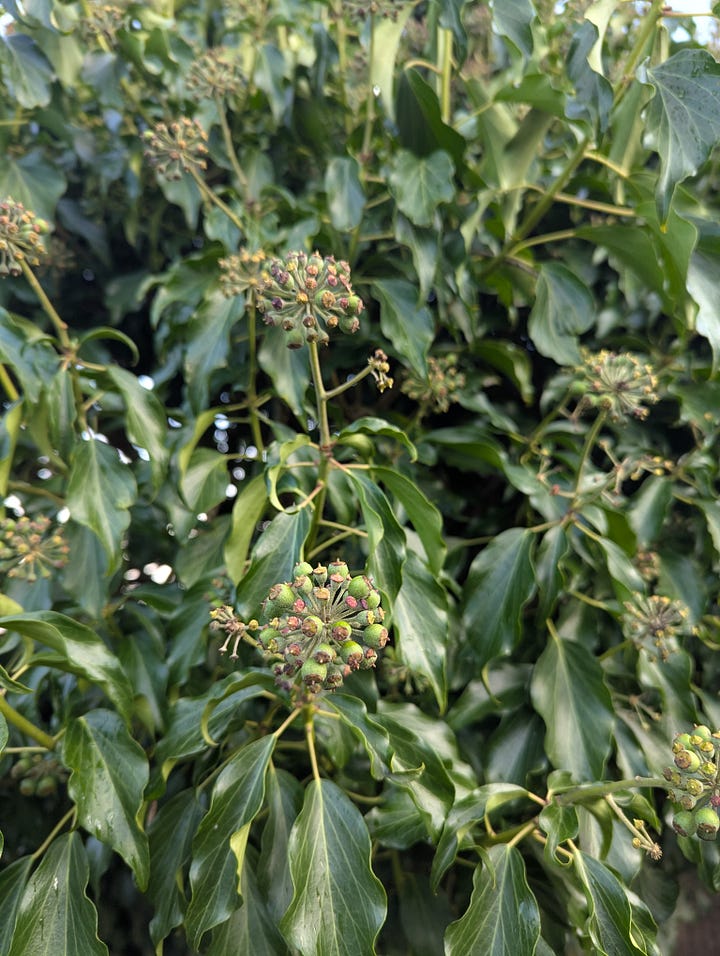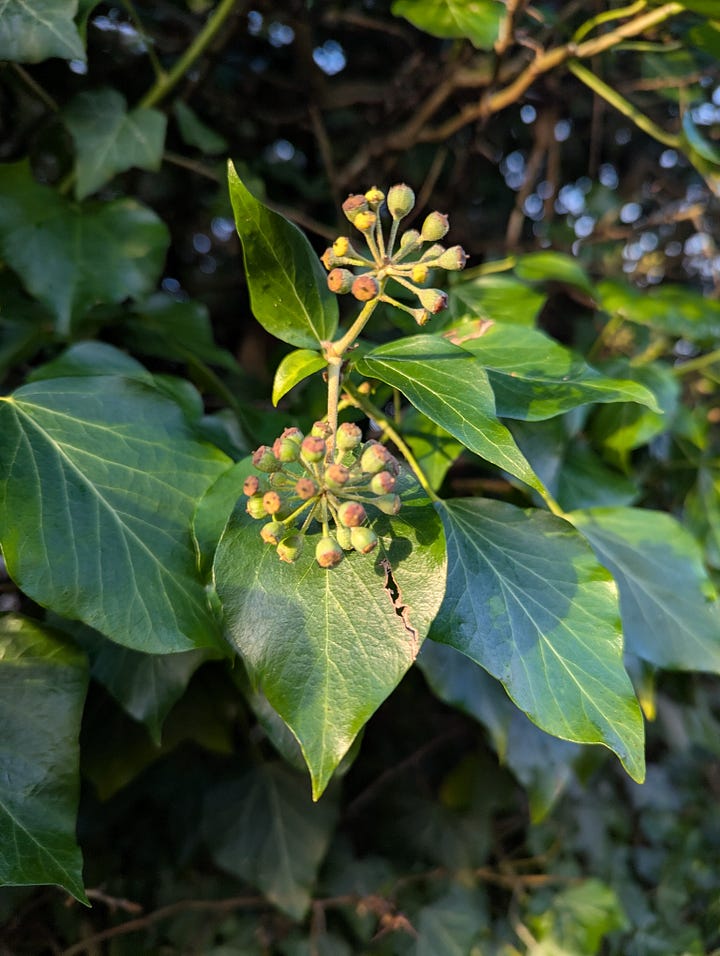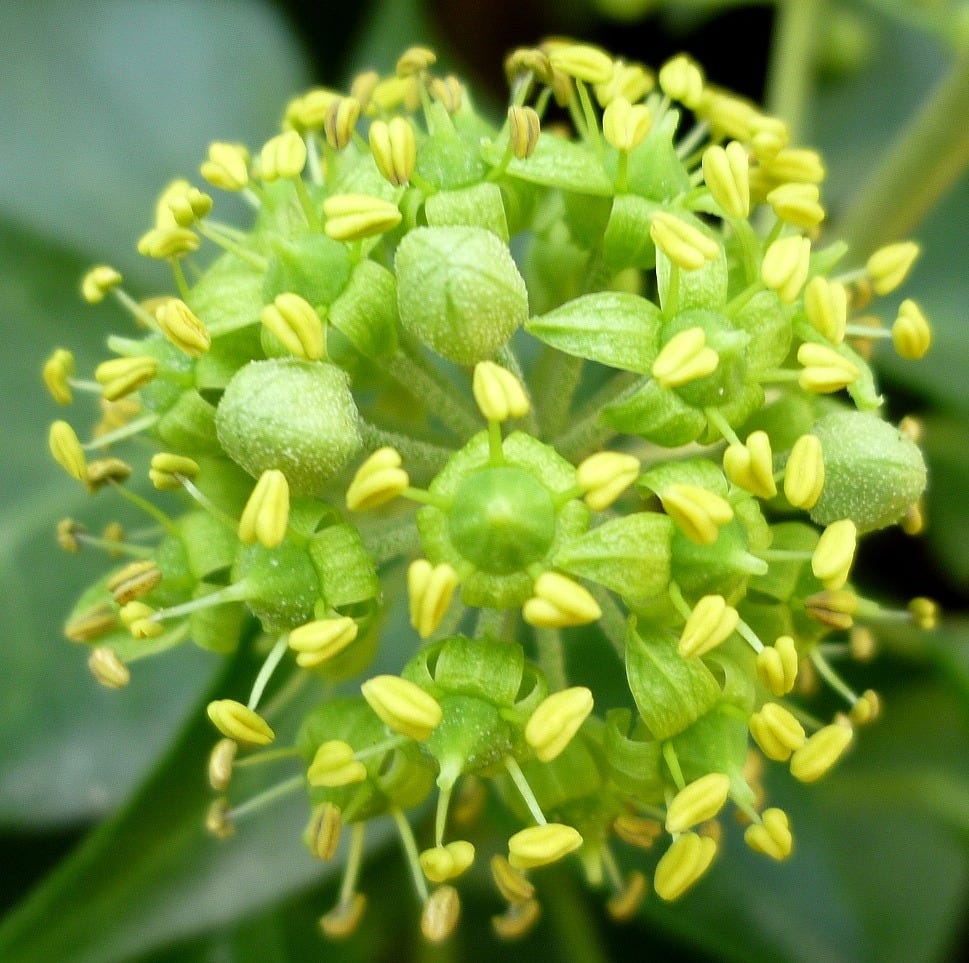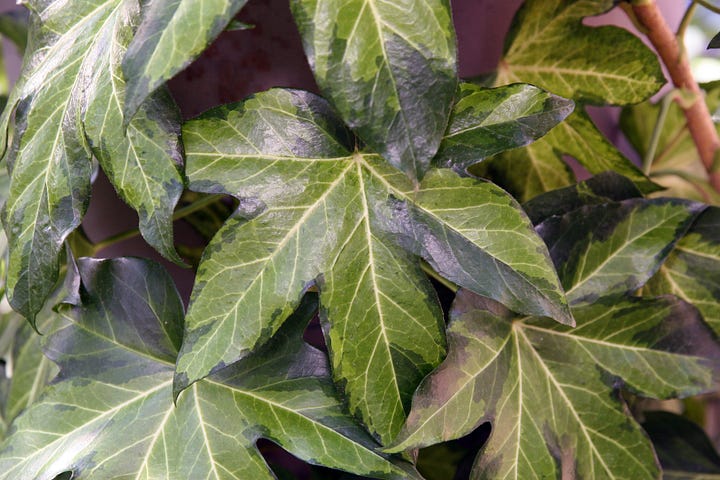I am in no way condoning your consumption of any Hedera species.
Do your own research.
Happy Winter Solstice to you all. Over here, the sun is stting
I was reminded of this apex by Jason Anthony’s poignant substack piece.
Consider this article my Winter Solstice gift to you, and the last one of 2024.
My hope is that you will have some measure of peace and contentment in 2025, whatever it might bring.
Regular readers will know that my articles revolve around the one simple question: “Can you eat that plant?”
And really, that’s all there is. When the winter comes and most of the easily edible greenery has faded away, my gaze turns to the more stubborn evergreens.
Don’t worry, I’m not talking about holly (yet). My sights are set on English Ivy.
Hedera helix divides opinion. It’s frequently accused of invasiveness, of destroying man-made exteriors, of smothering trees and probably other hidden crimes. I’ve seen English Ivy climb up telephone masts and trees, I’ve pulled it away from patches of my food forest.
On the other leaf, H. helix supports the ecosystem. It flowers when most other plants have long given up and so provides a large excess of nectar to pollinators that need that final push before the winter sets in. There’s a particularly healthy patch on a nearby street that is a local pollinator favourite. I’ve found a few bird nests in the ivy patch at the back of my property, which I'm sure has something to do with the calorie dense berries.




What got me onto English Ivy is the chapter in Ken Thompson’s book “Common or Garden”. He notes that this humble plant is the only “native” evergreen cold temperate liana in Britain, and well, I’d never even associated liana with anything other than a jungle, much less one in the frost. A veil had been lifted from my eyes.
H. helix belongs to the Araliaceae family of ginseng (Panax ginseng) fame. Both contain falcarinol, which is a pesticide that is also present in some Apiaceae such as the humble carrot (Daucus carota). Falcarinol is a heat and light unstable fungicide - so that’s a clue about how to store the harvested plant parts. Prolonged skin contact with falcarinol can induce dermatitis and even allergic reactions. Please wear gloves and a respirator if you plan on vapourising any carrots!
Plant Breeding Tangent
Araliaceae are mostly tropical but the Hedera genus have really pushed the genomic envelope and placed its flag squarely in cold biomes, including southern Iceland(!)
Crossing with Hedera helix with others in the same genus (H. hibernica, H. colchia, H. algeriaensis etc) should be relatively easy as they are all popular ornamental landscape plants. These crosses could be done to adjust the vigour, or to bring in other desirable traits such as increased fruit set or lower saponin content.
Luckily for us, all sorts of Hedera interspecific hybrids are already happening naturally due to proximity, with at least six documented crosses recorded as of 2017:
Three new infrageneric hybrids in Hedera are described. The names H. × sepulcralis, H. × cazorlensis and H. × nessensis are provided for hybrids between H. hibernica and H. algeriensis, H. helix and H. maroccana, and H. iberica and H. hibernica respectively.
Great news, the hard work has already been done by the pollinators. We can take advantage of this first step and do the fun plant trials instead.
Crossing with other Araliaceae is a more difficult prospect because Hedera have evolved to be one of the latest flowering plants in the UK, with all the benefits that that exclusive niche affords it.
An interesting breeding partner could be Tetrapanax papyrifer (Rice paper plant) whose stem is used to make a non-edible paper. This plant flowers in the autumn so with some tweaking it could be made to overlap.
Aralia chinensis (Chinese Angelical-tree) has edible shoots but more importantly has a tree form which can be used to adjust the growing pattern of Ivy to something more acceptable.
A cursory examination of seeds in the Araliaceae family show me that they’re all pretty high in protein and fat which is a good sign for any hybrid progeny. I’ve been examining some close up Hedera flower photos and the stamen and stamen are quite distinct which should make them easy to emasculate to ensure that any progeny are hybrids. You'll just need a steady hand, tweezers and a maybe magnifying glass.

I’ve found at least one, rather weak, partially fertile intergeneric hybrid called × Fatshedera lizei which is a readily sold ornamental that goes by the descriptive common name of tree ivy:
× Fatshedera lizei was created by crossing Fatsia japonica 'Moserii' (Moser's Japanese fatsia, the seed parent) and Hedera helix (common ivy, the pollen parent) at the Lizé Frères tree nursery at Nantes in France in 1912.
Quite a few of these intergeneric crosses are sold as clonal cultivars on the market with names like ‘Annemieke’, ‘Variegata’, ‘Compact’ and ‘Angyo Star’


I’d like to point out that I theorised those Hedera crosses before researching them and finding my thoughts play out in real life. I don’t generally pat myself on the back, but I am rather satisfied with my plant breeding foresight in this instance.
Ivy Leaf extract has long been used to treat respiratory problems. I stumbled across this ability whilst researching this article in a cold-addled stupor and decided to buy some to try. I think it worked, my end-of-cold cough has not been as prolonged and I’ve been, let’s say, expectorating more strongly.
Moving away from the leaves to the berries, I discovered an excellent, in-depth PhD thesis entitled “High value products from unused, indigenous plants” by a David Preskett of Bangor University (Wales, UK). Really, you can stop reading my article now and jump straight to that thesis, but here are some mind-blowing highlights:
“…the crude oil […] for the seeds is nearly 30 %, shown to be mostly a pure mixture of triacylglycerols that should be amenable to purification by standard techniques for edible oils […]”
“Kleiman and Spencer have reported the protein content at around 20 %. Combined with the TAG [triacylglycerols] (35 %) and the TIS [triterpene saponins] (25 %), there remains a further 20 % of the seed to be identified. The likely identity of the final components is probably sugars, starches, pectins and minor compounds.”
So, the oil we extract from the seeds is 30% triacylglycerols.
The leftover seed has about 20% protein, and possibly an extra 5% of triacylglycerols. The wording is unclear.
So altogether, the seed is made of 35% triacylglycerols, 20% protein, 25% triterpene saponins and a mystery 20% which is probably a mixture of sugars, starches, pectins and other minor compounds.
From the obligatory wikipedia page
Triglycerides [or triacylglycerols] are the main constituents of body fat in humans and other vertebrates as well as vegetable fat.
Cutting through the details, ivy oil extract (with appropriate processing) can be used as a cooking oil (and not just cooking, but furniture oil, machine lubrication, cosmetics and more).
A fairly large proportion of the seed is protein which is great news, but we are confounded by the higher amount of saponins.
Saponins tread the line (like most compounds) between medicinal and toxin though luckily they’re poorly absorbed by human digestion. Just don’t go around injecting vials into your veins.
Luckily for us, humanity has a storied history of removing saponins from food. Most of these techniques involve heat and water - you’ve probably heard of fishing by immersing saponin-rich plants in a body of water. More modern methods involve your everyday kitchen microwave. We regularly consume saponins through popular vegetables like legumes and asparagus. Liquorice is particularly high in saponins.
Together with the alleged pectin and sugars, we have - of course - some kind of jam material. More interesting to me is a partial meat substitute (say, adding to a meaty stew sauce).
To put things into perspective, the rapeseed plant contains about 48% fat and 20% protein. Compared to the 30% fat and 20% protein of ivy we’re just some careful domestication away from rivalling rapeseed levels (with none of that annually replanting kerfuffle).
Final Thoughts
Not even Ivy is safe from our bottomless maws.
Imagine this: a polyculture of oaks, chestnuts and other tree crops with Ivy climbing up their trunks, taking pride of place as the only evergreen frost hardy liana. After the autumn nut harvest, a harvest of ivy berries for processing to make butter, cooking oils with the left overs used to supplement meat dishes. We’re not even mentioning ivy leaf harvest to treat respiratory ailments - just in time for the cold and flu season and perfect for knocking back the ivy for next year. In another patch of this forest, some trials have begun to test some promising interspecies Hedera crosses that bear larger fruit with less saponins, whilst in another patch, some promising tree form intergeneric plantings are taking place - there’s an exciting oil crop canopy intergeneric hybrid that has the whole community buzzing.
What a great integrated system.
I’ll never look at Ivy in the same way again.
Until next time.
Further Reading
An Unusual Case of Death: Suffocation Caused by Leaves of Common Ivy (Hedera helix). Detection of Hederacoside C, α-Hederin, and Hederagenin by LC—EI/MS-MS
Safety of English ivy (Hedera helix) leaf extract during pregnancy: retrospective cohort study
Ivy leaf dry extract EA 575 for the treatment of acute and chronic cough in pediatric patients: review and expert survey
Removal of uranium(VI) and thorium(IV) from aqueous solution by Hedera helix leaves: kinetics and thermodynamic studies
High value products from unused, indigenous plants, David Preskett of Bangor University (Wales, UK)
Optimization of microwave-assisted extraction of triterpene saponins from defatted residue of yellow horn (Xanthoceras sorbifolia Bunge.) kernel and evaluation of its antioxidant activity
Perspectives on Saponins: Food Functionality and Applications
Whole Rapeseed nutrient content
A summary of hybrids detected in the genus Hedera (Araliaceae) with the provision of three new names
× Fatshedera lizei was created by crossing Fatsia japonica 'Moserii' (Moser's Japanese fatsia, the seed parent) and Hedera helix (common ivy, the pollen parent)




I always enjoy your pieces, some of the most interesting and unique looks at potential domesticates I ever read!
You transported me in your final thougths. Wow. Yes to your imagined food forest!